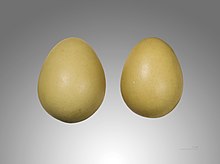Collar francolin
| Collar francolin | ||||||||||
|---|---|---|---|---|---|---|---|---|---|---|

Collared francolin ( Francolinus francolinus ) |
||||||||||
| Systematics | ||||||||||
|
||||||||||
| Scientific name | ||||||||||
| Francolinus francolinus | ||||||||||
| ( Linnaeus , 1766) |
The black francolin ( Francolinus francolinus ) is a species of the genus of Frankoline from the family of pheasant-like (Phasianidae) which is spread by Southern Europe to the North East India. It is slightly larger than a partridge and lives mostly on the ground. As a habitat it prefers shrub and meadow vegetation in dry and semi-arid areas.
The collared frankolin occurs in several subspecies in southern Europe and southern Asia. He is the state bird of the Indian state of Haryana .
Appearance
Collar francolins reach a body length between 31 and 36 centimeters. Males are usually slightly larger and weigh between 450 and 500 grams. Females, on the other hand, reach a body weight between 400 and 450 grams.
The partridge-sized male is almost entirely dark in pattern, with white spots on the back and flanks. It has a maroon neck ring, white spots on its cheeks, and brown wings . The legs are red and have a rear-facing spur. Flying collar francolins stand out due to their cinnamon-brown banded wings. The female is brown and has a maroon neck.
voice
The chant of the Halsbandfrankolinen consists of seven very loud, shrill stanzas, which can be heard at intervals of about 1 minute. Each individual stanza consists of seven short elements. The singing can be heard especially in spring. The rooster likes to sing the song from a hill or a bush.
Locomotion
The collar francolin runs extremely fast and agile on the ground. Unless he is worried, he will not be blown and will cover longer distances on foot. When running, the front body is inclined and the neck stretched out. When worried, it tries to escape continuously and only flies up three to four meters at the last moment, lays a certain distance horizontally in the air and then falls back into the thicket.
The flight is similar to that of the pheasant. Rapid wing beats and a glide phase before landing are characteristic.
distribution
The collar francolin is one of the few francolin that live outside of Africa . Its catchment area stretches from Cyprus through southeast Turkey and Iran to southwest Turkmenistan and northeast India . In Tuscany they are naturalized as hunting game.
In earlier times it was even more widespread. In southern Europe, for example, the collar francolin was found in southeastern Spain, Sicily and the Aegean islands. In these regions, however, it was already exterminated in the first half of the 19th century. In the rest of its distribution area, too, its populations and spread have been severely decimated by excessive hunting . The reintroduction of the Halsbandfrankolin was tried several times in different places, but it always failed.
The Halsbandfrankolin is a resident of semi-open landscapes that have bushes and forest edges. It occurs preferentially on the edges of wetlands.
Way of life
The Collared Frankolin prefers to live in areas with a lot of scrub and low vegetation. It builds its nest in shallow hollows on the ground, preferably on a shrub or a plant nest . The clutch contains 8-12 eggs . The eggs are spindle-shaped to short-oval with a shiny and smooth shell surface. The egg shell is very thick and has clear pores. Only the female breeds. The male is usually near the nest. The breeding season is 18 to 19 days. The young are led by both parent birds. The young birds are fully grown at around 35 days. The family usually stays together over the winter months.
The food of the Halsbandfrankolin consists of a wide variety of plants and insects . It is easiest to observe at Paphos Airport in Cyprus and in the vicinity. Cyprus is the only country where the population is slowly recovering.
supporting documents
literature
- Steve Madge , Phil McGowan, and Guy M. Kirwan : Pheasants, Partridges and Grouse. A Guide to the Pheasants, Partridges, Quails, Grouse, Guineafowl, Buttonquails and Sandgrouse of the world. Christopher Helm, London 2002, ISBN 0-7136-3966-0 .
- RL Potapov, VE Fling (HRSG): Handbook of the birds of the Soviet Union. Volume 4: Galliformes, Gruiformes. Aula Verlag, Wiesbaden 1989, ISBN 3-89104-417-8 .
Individual evidence
- ↑ Madge et al., P. 194
- ↑ Hans-Heiner Bergmann; Hans-Wolfgang Helb; Sabine Baumann; The voices of the birds of Europe - 474 bird portraits with 914 calls and chants on 2,200 sonograms , Aula-Verlag, Wiesbaden 2008, ISBN 978-3-89104-710-1 ; Pp. 83 and 84.
- ↑ Protopov & Fling, 1989, p. 38
- ↑ Protopov & Fling, 1989, p 41
- ↑ Collin Harrison, Peter Castell: Young birds, eggs and nests of birds in Europe, North Africa and the Middle East. 2nd Edition. Aula, Wiebelsheim 2004, ISBN 3-89104-685-5 . P. 111
Web links
- Francolinus francolinus in the endangered Red List species the IUCN 2008. Posted by: BirdLife International, 2008. Accessed January 7 of 2009.
- Videos, photos and sound recordings of Francolinus francolinus in the Internet Bird Collection
- Collar Frankolin - photo and description
- Collar francolin
- Feathers of the collar francolin

